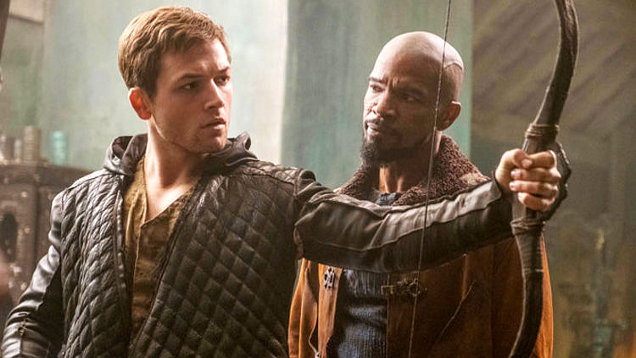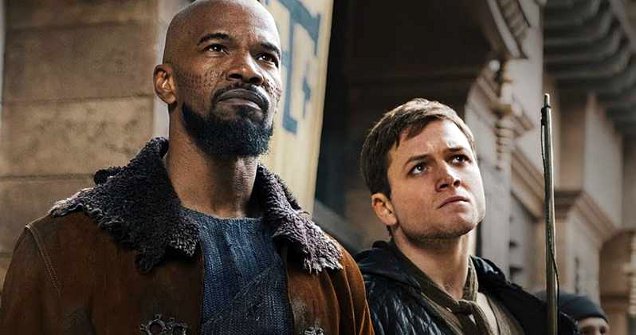Interview: How first-time film director Otto Bathurst reimagined Robin Hood for the 21st century

Do we really need another Robin Hood movie? That question was on the mind of director Otto Bathurst, as Sarah Ward discovers in her interview with the first-time feature filmmaker. The latest iteration of the iconic outlaw’s story arrives in cinemas November 22.
With arrows flying as fast as bullets, slick costuming and a generally frenetic atmosphere, Robin Hood returns to the big screen. Under director Otto Bathurst (TV’s Peaky Blinders, Black Mirror), this isn’t the standard take on the classic tale.
Instead, the new Robin Hood is an origin story that ramps up the action, starring Taron Edgerton as the hero who steals from the rich to give to the poor. In this version, the film’s protagonist is a returned soldier haunted by the realities of war and seeking revenge on the corrupt Sheriff of Nottingham (Ben Mendelsohn) who sent him to battle. Little John (Jamie Foxx) is Robin’s former enemy turned strategist, Marion (Eve Hewson) fights for the common people against the rich and powerful, and Friar Tuck (Tim Minchin) is a resourceful man of faith.
It’s a movie which differentiates itself in look, feel and narrative from the Kevin Costner and Russell Crowe-led movies from the past two decades – as can be expected in a film where Robin is known to the masses simply as “the Hood”.
With Robin Hood releasing on November 22, I spoke with Bathurst about his addition to the cinematic Robin Hood canon.
Robin Hood is clearly no stranger to the screen. What drew you to the tale?
When you first think about it, you think “really? Do we really need another Robin Hood?”. I went away and really dug into the story of Robin Hood and who he was. I realised, to my ignorance, that the story that has been told for 400, 500, 600 years in millions and millions of iterations. That got me really intrigued. You don’t become a legend in my mind for stealing a few bags of money from rich people and giving it to poor people. Clearly this guy represented something much bigger and stronger, and resonated much more with the public, whether that’s in the 12th century or the 18th century.
I began to realise that this was a man who was prepared to stand up against whatever oppression, corruption and evil was going on when the story was told. Those forces mutate and change throughout time, but ultimately there has always been and always will be a need for someone who’s going to go “hang on, I don’t buy this. I’m going to stand up. One man is going to make a change here.”
That felt really interesting and really inspiring, and very relevant. Perhaps more so now than ever, because now more than ever do we live in a global society where actually one voice can make a difference and can bring about change. When the world is in the state that it’s in now, we need people to be standing up against the abuse, the oppression, whatever.

How did you approach tackling this take on the story?
It’s about making a film that looks and feels relevant to a modern audience, rather than a gritty fairytale that you go, “cool that was then, but so what?”. That in my mind negates the purpose of the movie. Ultimately the movie is a huge blockbuster, but there is stuff in there that I hope might resonate with people.
They might go “wow, the church is still corrupt, and politicians are still really manipulative.” Or “wow, actually, one person can stand up and shout and make a difference and inspire people.” That all felt quite needed and contemporary.
What was your aim for the look of the film — the production design, the costuming and the action scenes?
I had no interest in just making a historically accurate medieval [version]. There is no historically accurate version of Robin Hood anyway. I wanted to make a version that people could look at and feel very real and visceral – and that you were in it, and that you connect it.
Nottingham in the 12th century would’ve looked nothing like that, and clearly they wouldn’t have worn clothes like that, but it was about creating a world that was alive.
It was like, what would it’ve felt like if you were seeing it at that time? A bow and arrow in the 12th century is the most terrifying weapon in the world. It’s horrific – it rips through you and it can kill you and it can wound you. You want to feel like that. That initial sequence in Syria is meant to feel as terrifying as what it would be like to be pinned down in Iraq by enemy gunfire, because ultimately it’s the same emotion. Whether you’re running away from a bow and arrow or from a bullet, it still feels the same. And the horse chases, they’re not meant to be beautiful, epic, mythical horse chases. They’re meant to be smash-and-grab car chases, because in the 12th century, that’s what a horse is. It’s a car.
Working with figures that are engrained in folklore and popular culture, how do you make them stand out from previous versions, while still recognising the history that comes with them?
Everyone considers these characters to be so ingrained, and they are, but only off the back of two or three versions of the story. There are so many different versions. Basically, we threw the whole thing out.
Robin is just a furious, angry, selfish guy who just wants to kill the sheriff. It’s Marion who’s already open to the bigger picture
I wanted to show a very real, relatable Robin – somebody who’s gone off to war and realised that the war he was fighting was for a man and a cause, and that the church and the country who were forcing him to kill his fellow brothers was corrupt and evil. It’s all very contemporary stuff. He comes back, and he feels disillusioned and lost, and he’s lost his girlfriend and he’s angry. That’s relatable.
Of the two characters that I redefined the most, that I was passionate about, the main one is Marion. I was very keen that Marion should not just be a damsel in distress. Ultimately in this movie, without Marion there is no Robin Hood. That was really dear to me, to show her being as powerful and wise and strong. Before Marion comes along, Robin is just a furious, angry, selfish guy who just wants to kill the sheriff. It’s Marion who’s already open to the bigger picture, who inspires him and shows him that actually his calling is much bigger than that.
The other one is Tuck, because Tuck is always depicted as this sort of stupid, fat idiot. I thought Tuck was a really interesting, complex character, a man who’s got real faith and a belief in god, but hates the organisation that he works for, and realises that the organisation he works for has got nothing to do with the faith that he has. That was quite an interesting conflict that hasn’t be shown before, and one that is there subtly.
With that in mind, how did you approach casting?
I didn’t want to go down the classic English old school ‘ye olde’ actors. I wanted a hotchpotch of actors and a hotchpotch of looks, to make every character feel unique and individual.
Tim as Tuck is a genius piece of casting – he’s amazing, and he’s an amazing guy full stop. He brought a real kind of charm to the guy, an intelligence and a wisdom. Also he’s brilliant at the comedy stuff as well.
Eve, I love as Maid Marion. She’s not your classic Hollywood actress, but she has an enormous power and individuality to her – she’s her own woman both on-screen and in real life.
Ben, as the sheriff – ever since Animal Kingdom I’ve adored Ben and wanted to work to him. For the sheriff, I didn’t want a bog-standard moustache-twirling baddie. I wanted somebody who initially you don’t quite read and you don’t know which way he’s going, like many politicians. These guys are super-intelligent masters of what they do. They are spin doctors of the highest degree. So you wanted somebody as layered as Ben.
What did you look for from Ben Mendelsohn, noting that he has been carving out that villainous niche in a number of films lately?
He has. To be honest, that was a worry. Hang on, has he overcooked the villain pot? I just think he’s a brilliant actor. With all the parts, you want to get the best actor – and you want somebody like Ben as the Sheriff of Nottingham.
In lesser hands, it just becomes a very one-dimensional baddie. What’s cool about what Ben did is that he just brought a real depth to him and a real intrigue to him. When he shows how abjectly immoral he is to Little John – these are cool scenes that are quite heavy. It’s an unusual film like that, because you’ve got full popcorn action sequences, and then you’ve got these scenes in there that are pretty intense in what’s being said and what’s being exposed.
Since Animal Kingdom, I’ve always thought that Ben is an absolute rock ‘n’ roll kind of movie star, but in a really individual, interesting way, of which there are very, very, very, very few these days. He’s genuinely unique – and you can count those on one hand.
















